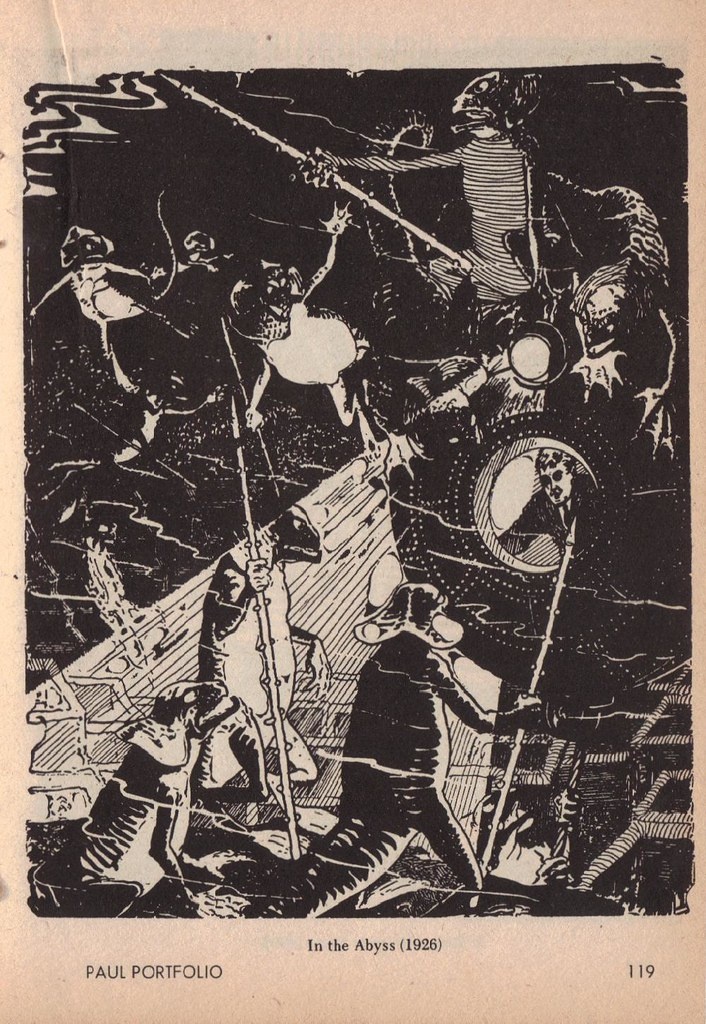“In the Abyss” is a short story by the English author H. G. Wells (1866–1946) first published in the August 1896 edition of Pearson’s MagazineMonthly publication founded by Cyril Arthur Pearson, published 1896–1939, the first British periodical to include a crossword., and subsequently in The Plattner Story and OthersCollection of 17 short stories by H. G. Wells, first published in 1897. (1897).[1] It tells of a descent to the deep ocean bed in a sphere, and an encounter with a previously unknown undersea civilisation.
Synopsis
The story is told as a third-person narrative by an unidentified narrator. Elstead has invented an apparatus by which a person can travel to great depths and observe the life on the sea bed. It is a steel sphere, about nine feet (3 m) in diameter, intended to withstand immense pressure. Weights attached to the sphere by a cable take it to the sea bed. The explorer makes observations through a window, and the oxygen inside is replenished by a Myers apparatus.[a]The Myers apparatus is fictional, but a device to absorb carbon dioxide and release its stored oxygen had been invented by Henry Fleuss in 1879.[2] A clockwork mechanism cuts the cable attaching the weights thirty minutes after the sphere strikes the sea bed, and the buoyancy of the sphere then takes it back to the surface.
The sphere is to be lowered into the water from the gunboat Ptarmigan, which has sailed to a region where the water is five miles (8 km) deep. The details of the sphere, and of Elstead’s plan to use it to view the ocean floor, are made clear in the conversations between Elstead and the ship’s officers, who have their misgivings about its ability to withstand the immense pressure it will be subjected to. The sphere is swung overboard at 11 o’clock in the morning, on a mission calculated to last for about thirty-five minutes, but the sphere still hasn’t re-emerged an hour later. While the ship’s officers wait, “the December sun was now high in the sky, and the heat very considerable.” By midnight, they are fearing the worst; then they spot the sphere, which is eventually retrieved at dawn.
When the sphere is opened, Elstead is found to be in “a state of absolute nervous collapse … and cruelly bruised”. After a week, he has recovered enough to tell of his experiences. He relates the eventful descent, lasting several minutes, during which the sphere became unexpectedly hot. On the sea bed, after observing the unusual species of fish and invertebrates, he sees “a strange vertebrated animal … The vertical pitch of its face gave it a most extraordinary resemblance to a human being … It was a biped; its almost globular body was poised on a tripod of two frog-like legs and a long thick tail.” This creature, together with others, tow the sphere to a kind of altar in their city; the inhabitants prostrate themselves before Elstead, and chant. He observes this for several hours: eventually the cable attaching the weights breaks, and the sphere returns to the surface.
The narrator has talked to eminent scientists, who think such an undersea civilisation is quite possible; he further speculates: “We should be known to them, however, as strange, meteoric creatures, wont to fall catastrophically dead out of the mysterious blackness of their watery sky. And not only we ourselves, but our ships, our metals, our appliances, would come raining down out of the night … One can understand, perhaps, something of their behaviour at the descent of a living man”.
Elstead never writes an account of his experience; after making improvements to the sphere, he makes another descent, but does not return from his second adventure.
Commentary
Elstead’s failure to return from his second descent mirrors the fate of the time traveller in Wells’s The Time Machine, published in 1895, the year before “In the Abyss”.
See also
- H. G. Wells bibliographyList of publications written by H. G. Wells during the more than fifty years of his literary career.

